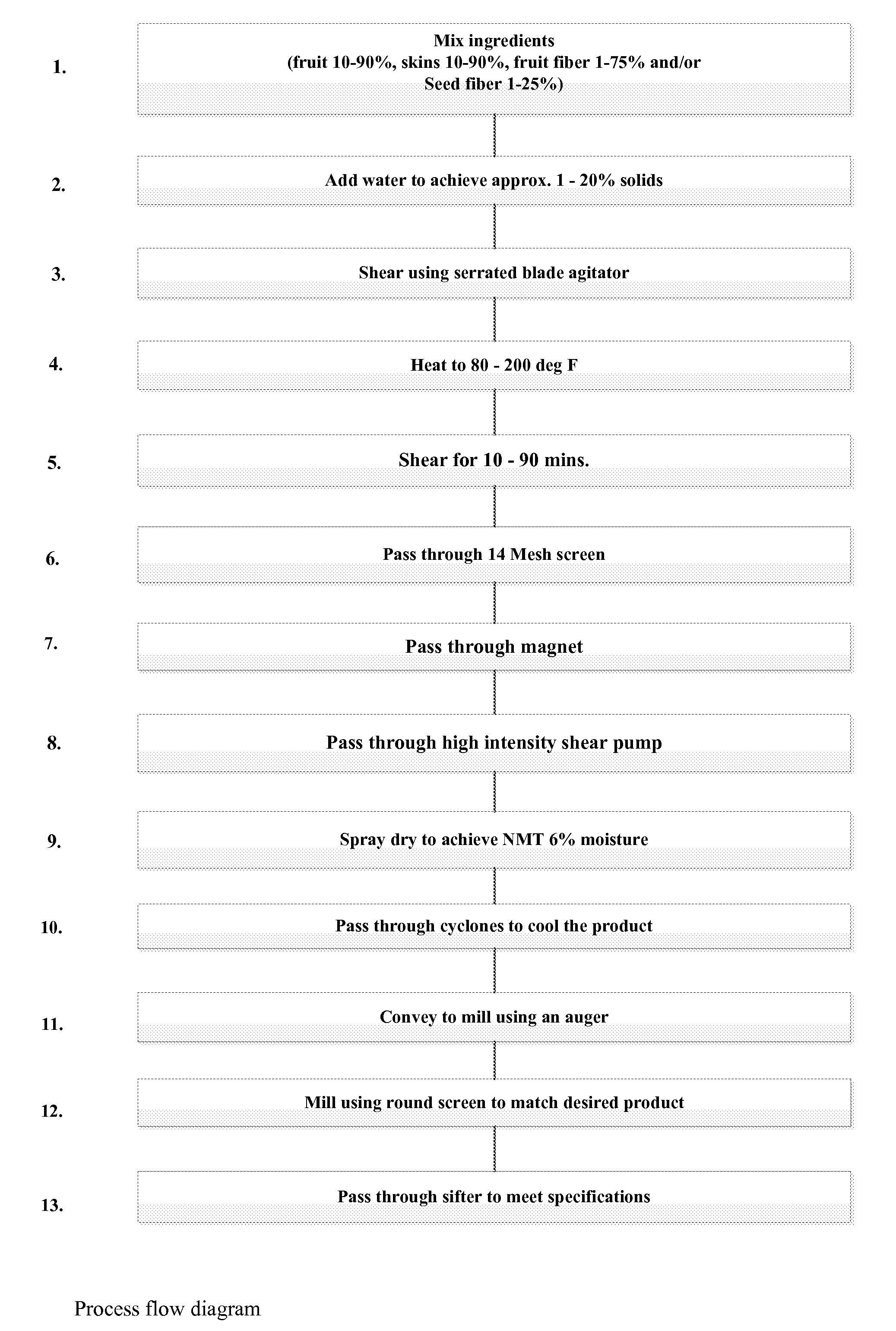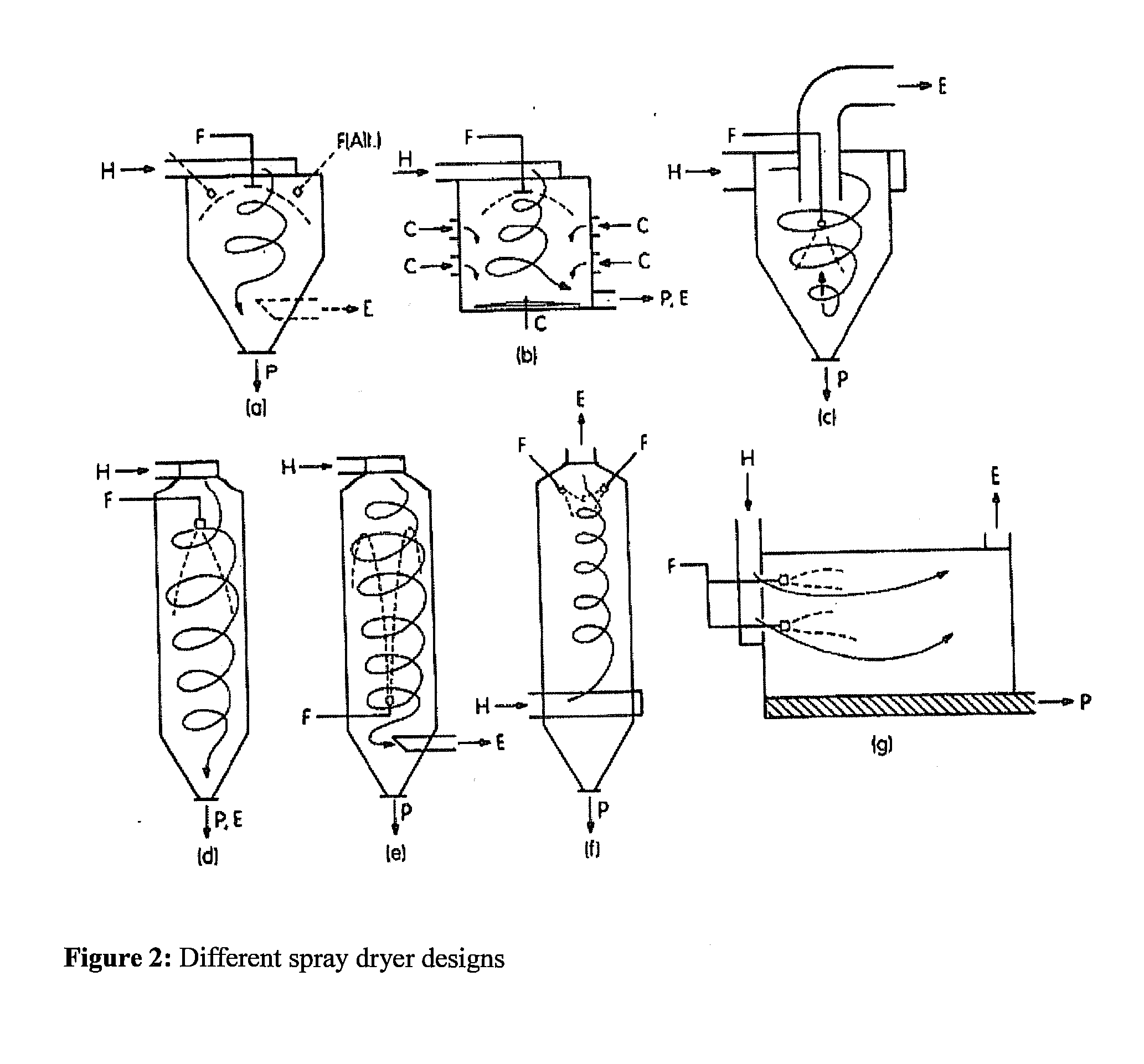Process for Spray Drying Botanical Food
a technology of botanical food and process, which is applied in the field of food preparation, can solve the problems of affecting taste, occupying a lot less space, and difficult to get fresh produce,
- Summary
- Abstract
- Description
- Claims
- Application Information
AI Technical Summary
Benefits of technology
Problems solved by technology
Method used
Image
Examples
example 1
[0093]The first example was conducted using cranberry skins. Approx. 1,000 lbs of cranberry skins were added to a tank with a Cowles disperser along with approx. 1,000 lbs of water. The Cowles disperser was used with a high shear blade to shear the product while mixing it. At dispersion speeds of 4,000 to 6,000 RPM, the Cowles disperser provided high velocity and turbulence to the mixture. A rapid hydraulic attrition zone was created which utilized shear and impact energies to achieve size reduction. The mixture was allowed to shear for approx. 30 mins. Following which the mixture was pumped into the feed tank and spray dried using the proprietary spray dryer build by GEA Westfalia.
[0094]The spray dried powder consisted of particles that were large in size and high in moisture. Initial moistures were 14-16%. The inlet and outlet temperatures were increased to bring the moisture down to 5-6%. The demand on the energy was significantly high and feed rate had to be reduced to meet thes...
example 2
[0095]The second example was conducted using cranberry skins and cranberry press cake (pomace). A target ratio of 3:1 was used. Approx. 2,000 lbs of skins and approx. 1,500 lbs of water were mixed in a tank with Cowles disperser. After shearing the mixture for 10 mins cranberry pomace was added in increments to the same tank. Total pomace to be added was 666 lbs to provide a ratio of 3:1 for skins and pomace on wet basis. But after adding the first 200 lbs of pomace all the water in the system dried up and the mixture did not flow well. Shearing the mixture was not possible. So another 500 lbs of water was added. This helped to shear the mixture but again as soon as another 200 lbs of pomace was added the water dried up. Additional 200 lbs of water was added, the mixture sheared and then all the remaining pomace was added. Final solids content was tested on the slurry and identified to be approx. 12.6%. The mixture was very thick and difficult to shear. So, water was added continuou...
example 3
[0096]The starting material in this example was 1,200 lbs of skins and 400 lbs of pomace, a 75:25 ratio for skins to pomace. The pomace was first introduced into the tank with the Cowles disperser. Next, 1,800 pounds of water was added and recorded, then the skins were added and the solid content checked. The solid content was found to be 12.7%. Following this, water was added water in increments of 400 lbs and checking the solids to understand how much water is needed. Finally, when the batch was ready the slurry was at 7.1% solids and sheared for 2 hours using the Arde Barinco reversible homogenizer.
[0097]The spray drying was then monitored based on previous settings to achieve 4-6% moisture. Based on the results the rate of drying was identified to be 80 lbs / hr which is almost 3 times slower than regular juice powder, which typically can be spray dried at 240 pounds / hour.
[0098]To improve the quality of the product, the product had to be sheared more. Additional equipment was next...
PUM
 Login to View More
Login to View More Abstract
Description
Claims
Application Information
 Login to View More
Login to View More - R&D
- Intellectual Property
- Life Sciences
- Materials
- Tech Scout
- Unparalleled Data Quality
- Higher Quality Content
- 60% Fewer Hallucinations
Browse by: Latest US Patents, China's latest patents, Technical Efficacy Thesaurus, Application Domain, Technology Topic, Popular Technical Reports.
© 2025 PatSnap. All rights reserved.Legal|Privacy policy|Modern Slavery Act Transparency Statement|Sitemap|About US| Contact US: help@patsnap.com



